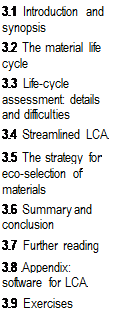|
|
|
Manufacture |
|
|
|
Resources |
|
Use |
|
|
|
Disposal |
3.1 Introduction and synopsis
The materials of engineering have a life cycle. They are created from ores and feedstock. These are manufactured into products that are distributed and used. Like us, products have a finite life, at the end of which they become scrap. The materials they contain, however, are still there; some (unlike us) can be resurrected and enter a second life as recycled content in a new product.
Life-cycle assessment (LCA) traces this progression, documenting the resources consumed and the emissions excreted during each phase of life. The output is a sort of biography, documenting where the materials have been, what they have done, and the consequences for their surroundings.

Image of casting courtesy of Skillspace; image of car making courtesy of U. S. Department of Energy EERE program; image of cars courtesy of Reuters. com; image of junk car courtesy of Junkyards. com.
LCA can take more than one form: a full LCA that scrutinizes every aspect of life (arduous and expensive in time and money), a briefer "character sketch" painting, an approximate (but still useful) portrait; or something in between. All, however, should observe certain boundary conditions. They take a bit of explaining.
This chapter is about the life cycle of materials and its assessment: how LCAs work, their precision (or lack of it), the difficulties of implementing them, and ways that these can be bypassed to guide material choice. It ends by introducing a strategy that is developed in the chapters that follow. The chapter includes an appendix describing currently available LCA software and the usual Further Reading and Exercises.






